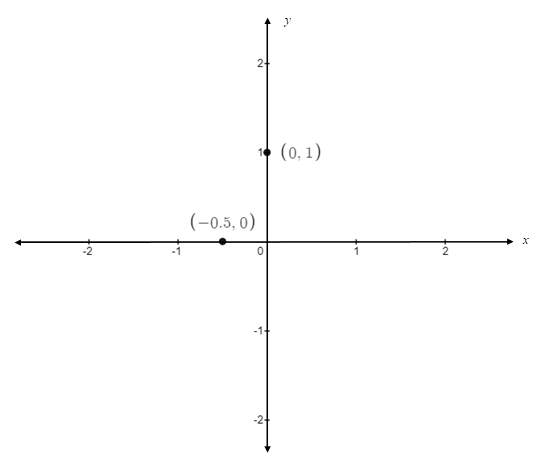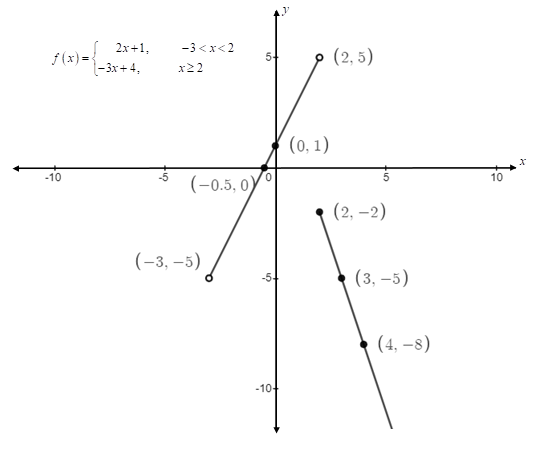
For the function
Find the domain of
Locate any intercepts.
Graph the function.
Based on the graph, find the range.
(a)
The domain of
Answer to Problem 21CR
Solution:
The domain of
Explanation of Solution
Given information:
The function
Explanation:
Here, the function
Thus, the function is defined on the interval
Therefore, the domain of the function is
(b)
To graph: The intercepts of the function
Explanation of Solution
Given information:
The function
Graph:
First, find the
First, find the intercepts for the function on interval
By substituting
Hence, the
Now, find the
By substituting
Hence, the
Now, find the intercepts for the function on interval
By substituting
Since,
Now, find the
Since, here
Hence, the intercepts to the function
Now, locate points
The graph is as follows:

Interpretation:
The graph represents the intercepts of the function
(c)
To graph: The function
Explanation of Solution
Given information:
The function
Graph:
From part (b)
The intercepts of the function on interval
Now, to graph the function on the interval
For
For
For
Now, plot the points
The graph of the function is as follows:

Interpretation:
There is break in the graph of function
(d)
The range of the function from the graph of function
Answer to Problem 21CR
Solution:
The range of the function is
Explanation of Solution
Given information:
The function
Explanation:
From part (c), the graph of the function

By observing the graph, the value of the function is less than
Hence, the range of the function is
Chapter 4 Solutions
Precalculus
Additional Math Textbook Solutions
Elementary Statistics: Picturing the World (7th Edition)
Thinking Mathematically (6th Edition)
A First Course in Probability (10th Edition)
Introductory Statistics
Algebra and Trigonometry (6th Edition)
Basic Business Statistics, Student Value Edition
- Consider the following system of equations, Ax=b : x+2y+3z - w = 2 2x4z2w = 3 -x+6y+17z7w = 0 -9x-2y+13z7w = -14 a. Find the solution to the system. Write it as a parametric equation. You can use a computer to do the row reduction. b. What is a geometric description of the solution? Explain how you know. c. Write the solution in vector form? d. What is the solution to the homogeneous system, Ax=0?arrow_forward2. Find a matrix A with the following qualities a. A is 3 x 3. b. The matrix A is not lower triangular and is not upper triangular. c. At least one value in each row is not a 1, 2,-1, -2, or 0 d. A is invertible.arrow_forwardFind the exact area inside r=2sin(2\theta ) and outside r=\sqrt(3)arrow_forward
- A 20 foot ladder rests on level ground; its head (top) is against a vertical wall. The bottom of the ladder begins by being 12 feet from the wall but begins moving away at the rate of 0.1 feet per second. At what rate is the top of the ladder slipping down the wall? You may use a calculator.arrow_forwardExplain the focus and reasons for establishment of 12.4.1(root test) and 12.4.2(ratio test)arrow_forwarduse Integration by Parts to derive 12.6.1arrow_forward
- Explain the relationship between 12.3.6, (case A of 12.3.6) and 12.3.7arrow_forwardExplain the key points and reasons for the establishment of 12.3.2(integral Test)arrow_forwardUse 12.4.2 to determine whether the infinite series on the right side of equation 12.6.5, 12.6.6 and 12.6.7 converges for every real number x.arrow_forward
 Calculus: Early TranscendentalsCalculusISBN:9781285741550Author:James StewartPublisher:Cengage Learning
Calculus: Early TranscendentalsCalculusISBN:9781285741550Author:James StewartPublisher:Cengage Learning Thomas' Calculus (14th Edition)CalculusISBN:9780134438986Author:Joel R. Hass, Christopher E. Heil, Maurice D. WeirPublisher:PEARSON
Thomas' Calculus (14th Edition)CalculusISBN:9780134438986Author:Joel R. Hass, Christopher E. Heil, Maurice D. WeirPublisher:PEARSON Calculus: Early Transcendentals (3rd Edition)CalculusISBN:9780134763644Author:William L. Briggs, Lyle Cochran, Bernard Gillett, Eric SchulzPublisher:PEARSON
Calculus: Early Transcendentals (3rd Edition)CalculusISBN:9780134763644Author:William L. Briggs, Lyle Cochran, Bernard Gillett, Eric SchulzPublisher:PEARSON Calculus: Early TranscendentalsCalculusISBN:9781319050740Author:Jon Rogawski, Colin Adams, Robert FranzosaPublisher:W. H. Freeman
Calculus: Early TranscendentalsCalculusISBN:9781319050740Author:Jon Rogawski, Colin Adams, Robert FranzosaPublisher:W. H. Freeman
 Calculus: Early Transcendental FunctionsCalculusISBN:9781337552516Author:Ron Larson, Bruce H. EdwardsPublisher:Cengage Learning
Calculus: Early Transcendental FunctionsCalculusISBN:9781337552516Author:Ron Larson, Bruce H. EdwardsPublisher:Cengage Learning





